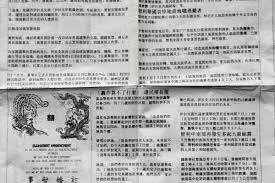The city of Kolkata, and possibly the entire country of India, has suffered a tragic loss with the potential disappearance of “The Overseas Chinese Commerce of India,” commonly known as “Seong Pow,” the only Mandarin newspaper in the region. This development strikes a devastating blow to the rapidly dwindling Chinese community in Kolkata and poses a significant threat to their cultural heritage.
The final edition of “Seong Pow” was printed just before the outbreak of the COVID-19 pandemic and subsequent lockdown in March 2020. The circulation of the newspaper was already halted during the initial wave of the pandemic, but the unfortunate demise of its editor, Kuo-tsai Chang, in July of the same year, dealt the final blow. As time passes, the prospect of reviving the newspaper grows increasingly unlikely, casting a somber shadow over the Chinese community’s aspirations.
Founded in 1969 by Lee Youn Chin, “Seong Pow” emerged 34 years after India’s first Chinese newspaper, “The Chinese Journal of India.” This four-page daily publication played a vital role by compiling news from China, Taiwan, Hong Kong, and Kolkata’s leading English newspapers, effectively translating them into Mandarin. In addition to delivering news, “Seong Pow” also served as a valuable platform for the close-knit Chinese community in Tangra’s Chinatown. It featured an extensive roster of wedding announcements, birth and death anniversaries, and party invitations, acting as their primary means of social connection long before the advent of modern-day social media.
The significance of “Seong Pow” extended far beyond its role as a news source. For the Chinese community, it represented a cultural lifeline, preserving their heritage and fostering a sense of unity among its members. The newspaper played a crucial part in keeping the community informed about events in their ancestral homeland and providing a platform for local news and events specific to their community.
The loss of “Seong Pow” not only leaves a void in the hearts of Kolkata’s Chinese community but also poses challenges to the preservation of their cultural identity. With each passing year, the chances of resurrecting the newspaper grow increasingly slim, further exacerbating the struggles faced by this minority group. The absence of a Mandarin newspaper not only hinders their access to relevant news but also severs an important thread connecting them to their Chinese roots.
In the face of this cultural setback, it becomes imperative for the Chinese community in Kolkata to explore alternative means of preserving their cultural heritage. Efforts could be made to establish online platforms or digital publications to serve as a modern-day successor to “Seong Pow.” Collaborations with other Chinese communities across India or even international Chinese organizations may also provide avenues for cultural exchange and revival.
As Kolkata continues to evolve, it is crucial that the city recognizes the importance of cultural diversity and takes steps to support and sustain the traditions and identities of all its communities. The legacy of “Seong Pow” will forever remain a testament to the resilience and vibrancy of the Chinese community in Kolkata, serving as a reminder of the valuable contributions they have made to the city’s multicultural fabric.


